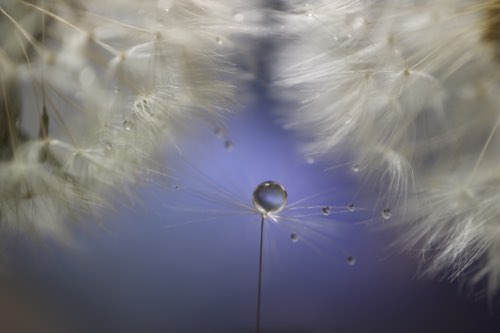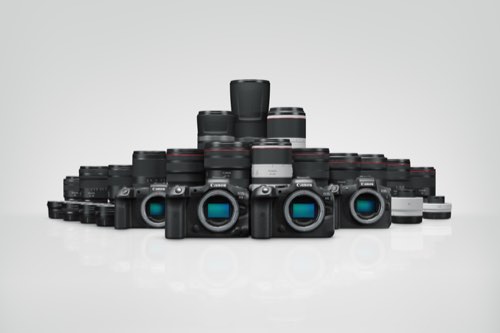Every time you zoom your lens in and out or change your lenses, you inevitably expose your image sensor to dust and dirt. When dust and dirt get stuck on your sensor, they result in dark spots on your image. To maintain good image quality, it’s good to clean your image sensor regularly—all the more so if you change your lenses frequently or shoot outdoors often. In this article, we guide you through the process. (Reported by: Ryosuke Takahashi)

An example of a photo taken with dust on the sensor. (Dust spots circled.)
How do I know that there’s dust on the image sensor?
When a speck of dust gets onto the surface of the image sensor, it blocks light from reaching that part of the sensor. This results in a dark spot on your image located where the dust is, as you can see circled in the image above.
How do I know that it’s sensor dust and not, say, dust in my lens?
It can be hard to identify whether the annoying spots that you see are due to sensor dust or dust inside your lens. Here are a few tell-tale signs that the dust is on your image sensor:
- The spots are in the exact same location in every shot.
- The spots look smaller and sharper when you use a narrow aperture.
- If you are using a DSLR, the spots will appear only in the image but not in the optical viewfinder. (On a mirrorless camera, the dust spots will appear in the electronic viewfinder “preview”.)
How to check for sensor dust
You can use the same characteristics mentioned above to check for sensor dust.
1. Set your aperture to the highest f-number possible.
2. Set the lowest ISO speed—you don't want any image noise interfering.
3. Point the camera to the sky or some other plain, light-coloured area.
4. Take a shot.
If there is dust on the sensor, the dust spots should show up quite obviously in the resulting image.

Sensor dust spots show up more obviously on plain backgrounds, which is why the sky is a good choice for your sensor dust test! If autofocus hunting prevents you from releasing the shutter, switch to manual focus and focus on a cloud, or anywhere else easy to focus on. Alternatively, focus to infinity. Some photographers feel that having the shot out of focus makes it easier to see dust spots, as any distracting subjects in the frame will be blurred.
Yikes, there is dust on my sensor. How do I remove it?
Two ways:
Method A: The camera’s built-in cleaning function
Method B: Manually using a blower.
Method A: Using the built-in cleaning function

1. From the Set-up menu, select "Sensor cleaning".

2. Select "Clean now" from the options available.

3. When you see this message display, select "OK" and press the SET button.

4. A "Sensor cleaning" screen will appear, and cleaning will start. The sensor will vibrate to shake off any dust attached to its surface.
Tips:
- When "Auto cleaning" is enabled, the camera's sensor self-cleaning function will automatically be activated every time you turn it on or off.
- For best results, make the the camera bottom is placed on a table or some other flat surface when you do the sensor cleaning.
- Method A is effective as it keeps your sensor clean enough to reduce the frequency of manual/professional cleaning. However, the dust that is "shaken off" will stay in the camera body. To prevent build-up, it's still good to clean your sensor manually every now and then,
Method B: For dust that cannot be removed with "Clean now"

1. Select "Sensor cleaning" in the Set-up menu, followed by "Clean manually"*.

2. A brief description appears, explaining the steps to perform cleaning manually. Read through the steps carefully and select "OK" before detaching the lens.

3. Detach the lens and blow off dust with a blower (*ensure that the blower does not come into direct contact with the sensor).
4. After you have finished cleaning, re-attach the lens and turn off the power of the camera to restore the mirror to the original position. Cleaning is now complete.
EOS M-series cameras
*The "Clean manually" function may not be present on some camera models such as those in the EOS M series. If that's the case, simply make sure the camera is off and detach the lens.
Important things to note
1. The surface of the image sensor is extremely fragile. Do not wipe it with anything
2. For dust that cannot be removed with the "Clean manually" option, do not try to remove it yourself by force. Bring the camera to a Canon Service Centre and have it cleaned professionally.
More camera and equipment care tips in the following:
How to Protect Your Camera for Cold Weather Photography
3 Reasons Why You Should Start Using a Lens Hood
3 Important Points to Care For Your Underwater Photography Equipment
Lens Care Tips (EOS World Singapore)
Care and Maintenance: Camera and Lens Care (Canon Professional Network)
Receive the latest update on photography news, tips and tricks.
Be part of the SNAPSHOT Community.
Sign Up Now!
































